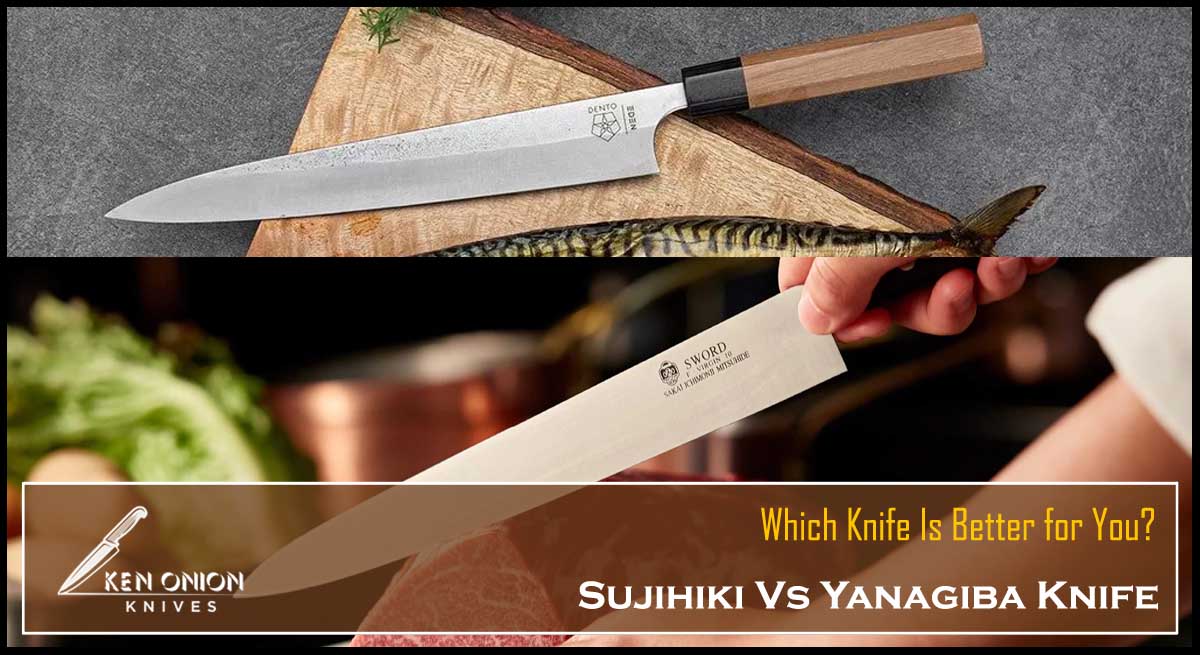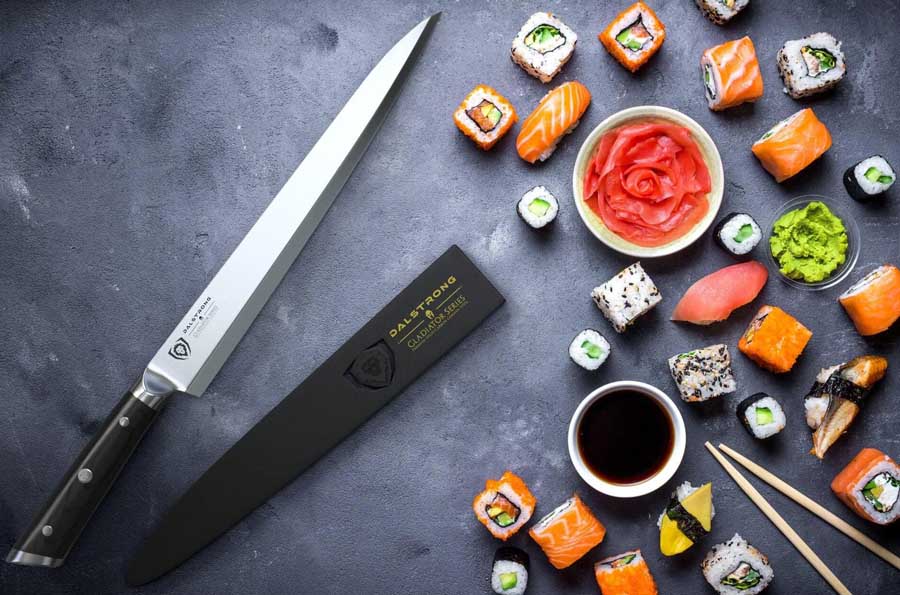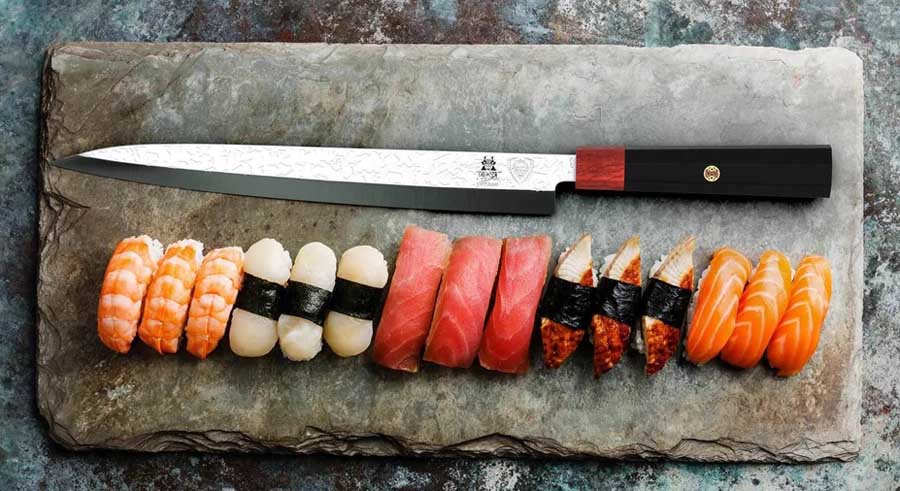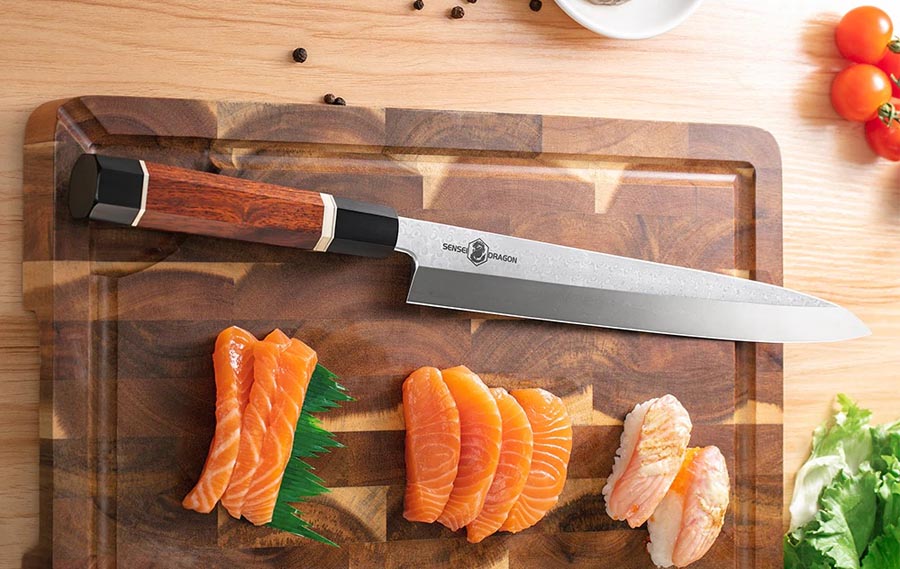Sujihiki Vs Yanagiba – Which Knife Is Better for You?
Are you looking for a Sujihiki Vs Yanagiba knife comparison? They are two of the most popular Japanese knives. The Sujihiki and Yanagiba knives are both popular blade styles for slicing raw meat.
There are many different types of knives available on the market, and it can be difficult to decide which type is best for your needs.
In this article, we will compare the Sujihiki vs Yanagiba knife to help you decide which is better for you. Both of these knives have their pros and cons, so read on to find out more!
What is a Sujihiki knife?
A Sujihiki knife is a Japanese-style slicing knife. It is long and thin, with a sharp point. The blade is usually made of high-carbon steel, which makes it very sharp.
The length of the blade ranges from 240mm to 360mm (9.5 inches to 14 inches). The most common length is 300mm (12 inches).
The name “Sujihiki” means “thin slicer”. This type of knife is used for slicing meat, fish, and vegetables. It can also be used for mincing and dicing.
Sujihiki knife uses.
The Sujihiki knife is mainly used for slicing raw meat. It can also be used for slicing cooked meat, fish, and vegetables.
The Sujihiki knife is also a good choice for home cooks who want to slice meat or vegetables for stir-fries, salads, or other dishes.
Sujihiki characteristics.
The Sujihiki knife has a long, thin blade. The blade is usually made of high-carbon steel, which makes it very sharp.
The length of the blade ranges from 240mm to 360mm (9.5 inches to 14 inches). The most common length is 300mm (12 inches).
The Sujihiki knife is well-balanced and easy to handle. It has a sharp point, which makes it great for slicing meat.
The Sujihiki knife is also known for its ability to create thin, even slices.
What is a Yanagiba knife?
A Yanagiba knife is also a Japanese-style slicing knife. It is long and thin, with a sharp point. The blade is usually made of high-carbon steel, which makes it very sharp. However, the blade is slightly curved, which helps to create smooth slices when cutting meat and fish.
The name “Yanagiba” means “willow blade”. This type of knife is used for slicing raw fish. It can also be used for mincing and dicing.
The length of the Yanagiba knife can range from 240mm (9.5 inches) to 360mm (14 inches). It is commonly used by professional chefs for sashimi and other types of fine slicing work.
Yanagiba knife uses.
The Yanagiba knife is mainly used for slicing raw fish. However, it can also be used for slicing other types of meat and vegetables.
Sashimi is one of the most popular dishes in Japan, so professional sushi chefs need a good quality Yanagiba knife to slice the fish perfectly.
Yanagiba characteristics.
The Yanagiba knife is made with a high-carbon steel blade. The blade is usually between 240mm and 360mm long. It is slightly curved, and the edge is very sharp.
The handle of the Yanagiba knife is usually made from wood, plastic, or bone. The handle should be comfortable to hold, and it should not slip when wet.
The Yanagiba knife is a single-beveled knife, which means that it can only be sharpened on one side. This makes it easier to create very thin slices of fish or meat.
Feature of Sujihiki knife?
Price.
The Sujihiki knife is a bit cheaper than the Yanagiba knife. If you are on a budget, the Sujihiki knife is a good choice.
Blade length.
The Sujihiki knife has a longer blade than the Yanagiba knife. This makes it a better choice for slicing large pieces of meat or fish.
Ease of use.
The Sujihiki knife is easy to use and well-balanced. It is a good choice for home cooks who are new to Japanese knives.
Brand.
Some of the best Sujihiki knives are made by Japanese knife companies like Shun and Global.
Design.
The Sujihiki knife has a traditional Japanese design. It is simple and elegant.
Materials.
The Sujihiki knife is usually made with high-carbon steel. This makes the blade very sharp.
Our recommended Sujihiki knife.
DALSTRONG Ultimate Sujihiki Slicing Knife.
The Blade.
The scalpel-like sharpness of the blade at an angle per side measuring 8° – 12°. It provides you with total slicing freedom, perfect for culinary challenges.
The AUS-10V Japanese super steel core is made up of 67 alternating layers of SUS410 Damascus, which give it incredible edge retention at 62+ Rockwell. It also has corrosion and rust resistance cladding panels to keep your knife cleaner for longer periods between sharpenings.
The blade is coarsely ground using a vertically rotating sharpening stone, then finely honed with the help of horizontally-moving stones. Finally, it’s polished to perfection by an experienced pro who knows exactly how close you can get without actually cutting yourself.
The Handle.
Powerful and durable, this knife is made from a material that can withstand heat cold, and moisture. With an ergonomic handle for superior control, you’ll be able to work longer hours without any issues.
The knife is like a work of art. It has an exquisite copper center rivet, which adds to its beauty and robustness at the same time! The tang of this tool makes it strong enough for anything you can throw at them – even if they are tough tasks like cutting through tough material.
Features.
The Blade Material is Japanese AUS-10V Super Steel
The Brand is Dalstrong
The Color is Black G10 handle
The Blade Edge is Hollow
The Blade Length is 10.5 Inches
Yoshihiro Damascus Sujihiki.
If you’re looking for a top-of-the-line slicing knife, the Yoshihiro Damascus Sujihiki is the perfect option. With its 46 layers of steel and VG-10 Core, this knife is designed to provide optimum performance and beauty.
The Damascus tradition with a VG-10 core makes this knife a perennial bestseller, combining performance, beauty, and extraordinary value.
So whether you’re handling big cuts of meat or fish, or simply slicing up some vegetables for dinner, the Yoshihiro Damascus Sujihiki is more than up to the task.
Features:
The Blade Material is VG-10 Stainless Steel
The Edge Angle is Double-Edged
The Grade is Damascus
The Handle Shape is Octagonal
The HRC is 60
The Knife Style is Sujihiki
The Saya Cover is Natural Magnolia Wood
The Stain Resistant is Yes
Feature of Yanagiba knife?
Curved blade.
The Yanagiba knife has a slightly curved blade, which helps to create smooth slices when cutting fish or meat.
Edge.
The Yanagiba knife has a slightly curved edge, which helps to create smooth slices when cutting meat and fish.
Handle.
The Yanagiba knife usually has a wooden, plastic, or bone handle. The handle should be comfortable to hold, and it should not slip when wet.
Blade.
The Yanagiba knife is made with a high-carbon steel blade. The blade is usually between 240mm and 360mm long. It is slightly curved, and the edge is very sharp.
Type of food.
The Yanagiba knife is mainly used for slicing raw fish. It can also be used for mincing and dicing.
Sashimi.
The Yanagiba knife is a good choice for slicing sashimi-grade fish.
Our recommended Yanagiba knife.
Dalstrong Yanagiba Sushi Knife.
The Blade.
The Dalstrong Yanagiba Sushi Knife is a traditional Japanese-designed single-bevel blade that is sharp enough to tackle any culinary challenge. The blade is made of solid AUS-10V Japanese super steel, which is incredibly durable and has excellent edge retention. The knife is also rust and corrosion-resistant, making it easy to clean and maintain.
The sharp blade is ground and honed using ancient techniques, resulting in a razor-sharp edge that can easily slice through fish and vegetables. The engraved lion head logo adds a touch of elegance to this already impressive knife.
The Handle
This Dalstrong Yanagiba Sushi Knife is the perfect tool for professional chefs and enthusiasts alike. Meticulously constructed with a G10 handle and stunning red rosewood, this knife is incredibly strong and durable.
The traditional Japanese “Wa” octagonal handle shape provides an ergonomic grip and increases tactile feedback, while the intricate copper mosaic pin adorns the center rivet. Every Ronin Series knife includes a premium quality handcrafted wood saya (sheath) to protect your blade safely and securely.
Features:
The Blade Material is Japanese AUS-10V Super Steel
The Brand is Dalstrong
The Color is Nitrogen cooled AUS-10V Damascus 66-layers.
The Handle Material is Alloy Steel
The Blade Edge is Plain
Yanagiba Knife & Deba Knife Set.
Looking for a top-quality, affordably priced kitchen knife set? Look no further than this Yanagiba Knife & Deba Knife Set, handmade in the style of Sakai craftsmen using traditional Japanese swordmaking techniques.
The set includes a Yanagiba knife, ideal for slicing up raw fish and fish fillets, and a Deba knife, perfect for tougher jobs like cutting through bones and cartilage. Give the gift of fine quality and precision with this knife set – perfect for any fishing or cooking lover in your life!
Features:
The Blade Material is Alloy Steel
The Brand is Houcho
The Construction Type is Forged
The Item Weight is 580 Grams
Sujihiki Vs Yanagiba – The similarities.
Style.
Both the Sujihiki and Yanagiba knives are Japanese-style slicing knives. They are both long and thin, with sharp points.
Blade Material.
Both knives are usually made with high-carbon steel blades. This makes the blade very sharp.
Sharp points.
Both knives have sharp points, which makes them great for slicing meat and fish.
Sujihiki Vs Yanagiba – The difference.
Blade length.
The Sujihiki knife has a longer blade than the Yanagiba knife. This makes it a better choice for slicing large pieces of meat or fish.
Price.
The Sujihiki knife is a bit cheaper than the Yanagiba knife. If you are on a budget, the Sujihiki knife is a good choice.
Weight.
The Sujihiki knife is lighter than the Yanagida knife. This makes it easier to use for extended periods of time.
Yanagiba knives are the workhorse of any kitchen due to their thicker spine which allows them better control when cutting.
Type of food.
The Yanagiba knife is mainly used for slicing raw fish. It can also be used for mincing and dicing. The Sujihiki knife is a good choice for slicing sashimi-grade fish.
Purpose.
The Yanagiba knife is designed for slicing fish and other delicate meats. The Sujihiki knife is designed for slicing all types of meat, including tough cuts of beef.
Steel.
The Yanagiba knife is made with softer steel than the Sujihiki knife. This makes it easier to sharpen, but it also means that the blade will dull more quickly.
Handle.
The Yanagiba knife usually has a wooden, plastic, or bone handle. The handle should be comfortable to hold, and it should not slip when wet. The Sujihiki knife has a traditional Japanese design. It is simple and elegant.
Design.
The Sujihiki knife has a traditional Japanese design. It is simple and elegant. The Yanagiba knife has a slightly curved blade, which helps to create smooth slices when cutting fish or meat.
Use.
The Sujihiki knife is easy to use and well-balanced. It is a good choice for home cooks who are new to Japanese knives. The Yanagiba knife is slightly more difficult to use, but it is still a good choice for home cooks.
Yanagiba blades require a high skill level and sharpness to use properly while Sujihiki needs less effort from you as it can be handled with relative ease by beginners or even those who aren’t too skilled at using cutlery effectively altogether!
Width.
The Sujihiki knife is wider than the Yanagiba knife. This makes it a better choice for slicing thick cuts of meat.
Blade shape.
Sujihiki Vs Yanagiba, The main difference between themes is their blade shape, The Sujihiki knife has a straight blade, while the Yanagiba knife has a slightly curved blade. The curved blade of the Yanagiba knife helps to create smooth, clean slices.
The Yanagiba blade is slightly curved, which creates a non-stick surface for slicing food.
Country of origin.
The Sujihiki knife is a Japanese knife, while the Yanagiba knife is a Chinese knife.
Bevel.
The Sujihiki knife is double-beveled, which means that it can be sharpened on both sides. The Yanagiba knife is single-beveled, which means that it can only be sharpened on one side.
Edge.
The Yanagiba knife has a slightly curved edge, which helps to create smooth slices when cutting meat and fish. The Sujihiki knife has a straight edge, which is good for slicing all types of meat, including tough cuts of beef.
Sujihiki Vs Yanagiba: The winer?
The Sujihiki knife is a good choice for home cooks who are new to Japanese knives. It is easy to use and well-balanced.
The Yanagiba knife is a good choice for sushi chefs or other professionals who need to slice fish or meat very thinly.
The Yanagiba knife is also a good choice for home cooks who want to try their hand at slicing fish or meat. However, the Yanagiba knife is slightly more difficult to use than the Sujihiki knife.
Tips for using a Sujihiki or Yanagiba knife?
Tips for using a Sujihiki knife.
– Use a cutting board that is slightly larger than the blade of the knife.
– Use a slicing motion when cutting, and avoid sawing back and forth.
– When slicing meat, fish, or vegetables, start with the item that is most dense and work your way to the item that is least dense.
Tips for using a Yanagiba knife.
– Soak the knife in water for 10-15 minutes before use.
– Use a slicing motion when cutting, and avoid sawing back and forth.
– When slicing raw fish, start with the item that is most dense and work your way to the item that is least dense.
FAQs about Sujihiki Vs Yanagiba.
What are some good brands of Sujihiki and Yanagiba knives?
Some good brands of Sujihiki knives include Tojiro, Shun, and MAC.
Some good brands of Yanagiba knives include Ginga, Masamoto, and Takamura.
How do you care for and maintain your Sujihiki or Yanagiba knives?
To care for your Sujihiki or Yanagiba knife, you should avoid putting it in the dishwasher. You should also avoid cutting through bones or hard vegetables.
To sharpen your knife, you will need to use a whetstone. First, soak the whetstone in water for 10-15 minutes. Then, use a sharpening angle of 10-15 degrees to sharpen your knife.
How do I choose the right size Sujihiki or Yanagiba knife?
The size of the knife you need will depend on what you plan to use it for. If you plan to slice meat, fish, or vegetables, a 9-10 inch knife should be sufficient.
If you plan to slice raw fish, a 10-12 inch knife would be a better choice.
Finally, if you are a professional chef or sushi chef, you may want to choose a Yanagiba knife that is 14 inches or longer.
Safety when using Sujihiki or Yanagiba knives?
As with any knife, there are certain safety precautions you should take when using a Sujihiki or Yanagiba knife.
– Always keep the blade of the knife pointing away from you.
– When slicing, use a slicing motion and avoid sawing back and forth.
– Be extra careful when cutting through bones or hard vegetables.
– Never put your knife in the dishwasher.
– Always sharpen your knife with a whetstone, using a sharpening angle of 10-15 degrees.
Sujihiki Vs Yanagiba – What is the main difference?
The main difference between these two types of knives is their blade. The Sujihiki has a straight blade, whereas the Yanagiba has a slightly curved blade.
Another difference is that the Sujihiki is mainly used for slicing meat, fish, and vegetables. The Yanagiba is mainly used for slicing raw fish.
Finally, the Sujihiki is a double-beveled knife, which means it can be sharpened on both sides. The Yanagiba is a single-beveled knife, which means it can only be sharpened on one side.
Why are Sujihiki and Yanagiba knives so expensive?
Sujihiki and Yanagiba knives can be expensive because they are made with high-quality materials and are designed for professional use.
– Sujihiki knives are made with high-quality stainless steel that is resistant to rust and corrosion.
– Yanagiba knives are made with high-quality carbon steel that is specially designed for slicing raw fish.
– Both types of knives are designed for professional use and are made with durable materials that will last for many years.
How often should I sharpen my Sujihiki or Yanagiba knife?
You should sharpen your knife every time you use it. If you don’t sharpen your knife, the blade will become dull and will not be able to slice through meat, fish, or vegetables as easily.
To sharpen your knife, you will need to use a whetstone. First, soak the whetstone in water for 10-15 minutes. Then, use a sharpening angle of 10-15 degrees to sharpen your knife.
Can you fillet with a Yanagiba?
No, you cannot fillet with a Yanagiba knife. This type of knife is not designed for filleting fish. Instead, it is designed for slicing raw fish. If you want to fillet a fish, you will need to use a different type of knife, such as a boning knife or a fillet knife.
Can you use Yanagiba to slice meat?
Yes, you can use a Yanagiba knife to slice meat. However, it is not the best type of knife for this purpose. The blade of a Yanagiba knife is long and thin, which makes it difficult to control when slicing meat. If you want to slice meat, you should use a different type of knife, such as a Sujihiki knife or a Santoku knife.
Conclusion.
Sujihiki vs Yanagiba knives, as you can see, there are some key differences. So, which one is right for you?
If you’re looking for a knife that will make quick, clean slices with minimal effort, go with the Sujihiki. But if you want a knife that will give you more precision and control when slicing delicate items, the Yanagiba is the better choice.
In the end, it really comes down to personal preference. Both knives have their pros and cons, and what might be the best knife for one person might not be the best for someone else. If you’re still undecided on which knife to choose, our team can help you make a decision based on your needs and preferences.








